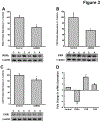Immunization and Drug Metabolizing Enzymes: Focus on Hepatic Cytochrome P450 3A
- PMID: 33666138
- PMCID: PMC8292194
- DOI: 10.1080/14760584.2021.1899818
Immunization and Drug Metabolizing Enzymes: Focus on Hepatic Cytochrome P450 3A
Abstract
Objective: Infectious disease emergencies like the 2013-2016 Ebola epidemic and the 2009 influenza and current SARS-CoV-2 pandemics illustrate that vaccines are now given to diverse populations with preexisting pathologies requiring pharmacological management. Many natural biomolecules (steroid hormones, fatty acids, vitamins) and ~60% of prescribed medications are processed by hepatic cytochrome P450 (CYP) 3A4. The objective of this work was to determine the impact of infection and vaccines on drug metabolism.
Methods: The impact of an adenovirus-based vaccine expressing Ebola glycoprotein (AdEBO) and H1N1 and H3N2 influenza viruses on hepatic CYP 3A4 and associated nuclear receptors was evaluated in human hepatocytes (HC-04 cells) and in mice.
Results: CYP3A activity was suppressed by 55% in mice 24 h after administration of mouse-adapted H1N1, while ˂10% activity remained in HC-04 cells after infection with H1N1 and H3N2 due to global suppression of cellular translation capacity, indicated by reduction (70%, H1N1, 56%, H3N2) of phosphorylated eukaryotic translation initiation factor 4e (eIF4E). AdEBO suppressed CYP3A activity in vivo (44%) and in vitro (26%) 24 hours after infection.
Conclusion: As the clinical evaluation of vaccines for SARS-CoV-2 and other global pathogens rise, studies to evaluate the impact of new vaccines and emerging pathogens on CYP3A4 and other metabolic enzymes are warranted to avoid therapeutic failures that could further compromise the public health during infectious disease emergencies.
Keywords: Cytochrome P450 3A4; drug metabolism; ebola; influenza; liver; vaccine.
Conflict of interest statement
Figures





Similar articles
-
Liver cytochrome P450 3A ubiquitination in vivo by gp78/autocrine motility factor receptor and C terminus of Hsp70-interacting protein (CHIP) E3 ubiquitin ligases: physiological and pharmacological relevance.J Biol Chem. 2010 Nov 12;285(46):35866-77. doi: 10.1074/jbc.M110.167189. Epub 2010 Sep 6. J Biol Chem. 2010. PMID: 20819951 Free PMC article.
-
Puromycin-based purification of cells with high expression of the cytochrome P450 CYP3A4 gene from a patient with drug-induced liver injury (DILI).Stem Cell Res Ther. 2022 Jan 10;13(1):6. doi: 10.1186/s13287-021-02680-4. Stem Cell Res Ther. 2022. PMID: 35012658 Free PMC article.
-
In vitro evaluation of hepatotoxic drugs in human hepatocytes from multiple donors: Identification of P450 activity as a potential risk factor for drug-induced liver injuries.Chem Biol Interact. 2016 Aug 5;255:12-22. doi: 10.1016/j.cbi.2015.12.013. Epub 2015 Dec 21. Chem Biol Interact. 2016. PMID: 26718876
-
[Effects of intestinal flora on the expression of cytochrome P450 3A in the liver].Yakugaku Zasshi. 2012;132(3):301-10. doi: 10.1248/yakushi.132.301. Yakugaku Zasshi. 2012. PMID: 22382834 Review. Japanese.
-
Mini-series: I. Basic science. Uncertainty and inaccuracy of predicting CYP-mediated in vivo drug interactions in the ICU from in vitro models: focus on CYP3A4.Intensive Care Med. 2009 Mar;35(3):417-29. doi: 10.1007/s00134-008-1384-1. Epub 2009 Jan 9. Intensive Care Med. 2009. PMID: 19132343 Review.
Cited by
-
Assessment of In Vitro Models of the Human Buccal Mucosa for Vaccine and Adjuvant Development.Mol Pharm. 2025 Jun 2;22(6):2868-2880. doi: 10.1021/acs.molpharmaceut.4c01186. Epub 2025 Mar 26. Mol Pharm. 2025. PMID: 40139941
-
COVID-19 Vaccines and the Virus: Impact on Drug Metabolism and Pharmacokinetics.Drug Metab Dispos. 2023 Jan;51(1):130-141. doi: 10.1124/dmd.122.000934. Epub 2022 Oct 23. Drug Metab Dispos. 2023. PMID: 36273826 Free PMC article. Review.
-
The Immature Infant Liver: Cytochrome P450 Enzymes and their Relevance to Vaccine Safety and SIDS Research.Int J Med Sci. 2025 Apr 28;22(10):2434-2445. doi: 10.7150/ijms.114402. eCollection 2025. Int J Med Sci. 2025. PMID: 40386062 Free PMC article.
-
CYP1B1 knockout enhanced IFN-γ production is required but not sufficient for protection of cigarette smoke-exposed mice against lethal influenza virus infection.Front Immunol. 2025 Jul 4;16:1600025. doi: 10.3389/fimmu.2025.1600025. eCollection 2025. Front Immunol. 2025. PMID: 40688072 Free PMC article.
-
Herpes zoster mRNA vaccine induces superior vaccine immunity over licensed vaccine in mice and rhesus macaques.Emerg Microbes Infect. 2024 Dec;13(1):2309985. doi: 10.1080/22221751.2024.2309985. Epub 2024 Feb 11. Emerg Microbes Infect. 2024. PMID: 38258878 Free PMC article.
References
-
- Ortiz de Montellano PR (2019) The Cytochrome P450 Oxidative System In Pearson PG, Wienkers LC (Eds.), Handbook of Drug Metabolism, Third Edition, Boca Raton, FL, CRC Press, pp. 57–83.
-
- Coleman MD (2020) Drug Biotransformational Systems – Origins and Aims, In Human Drug Metabolism Third Edition, Hoboken, NJ, Wiley-Blackwell, pp.17–97.
-
- United States Food and Drug Administration, 2020, Drug Development and Drug Interactions: Table of Substrates, Inhibitors and Inducers, accessed 26 January 2021, <https://www.fda.gov/drugs/drug-interactions-labeling/drug-development-an...>
Publication types
MeSH terms
Substances
Grants and funding
LinkOut - more resources
Full Text Sources
Other Literature Sources
Medical
Research Materials
Miscellaneous
